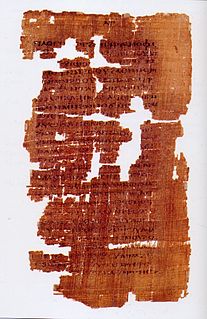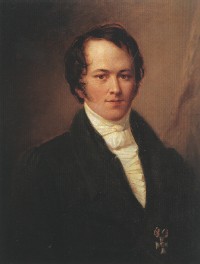Related Research Articles

Apocrypha are works, usually written, of unknown authorship or of doubtful origin. The word apocryphal (ἀπόκρυφος) was first applied to writings which were kept secret because they were the vehicles of esoteric knowledge considered too profound or too sacred to be disclosed to anyone other than the initiated. Apocrypha was later applied to writings that were hidden not because of their divinity but because of their questionable value to the church. In general use, the word apocrypha has come to mean "false, spurious, bad, or heretical".

Matthias was, according to the Acts of the Apostles, chosen by the apostles to replace Judas Iscariot following the latter's betrayal of Jesus and his subsequent death. His calling as an apostle is unique, in that his appointment was not made personally by Jesus, who had already ascended into heaven, and it was also made before the descent of the Holy Spirit upon the early Church.

The Gospel of Nicodemus, also known as the Acts of Pilate, is an apocryphal gospel claimed to have been derived from an original Hebrew work written by Nicodemus, who appears in the Gospel of John as an associate of Jesus. The title "Gospel of Nicodemus" is medieval in origin. The dates of its accreted sections are uncertain, but the work in its existing form is thought to date to around the 4th or 5th century AD.

The New Testament apocrypha are a number of writings by early Christians that give accounts of Jesus and his teachings, the nature of God, or the teachings of his apostles and of their lives. Some of these writings have been cited as scripture by early Christians, but since the fifth century a widespread consensus has emerged limiting the New Testament to the 27 books of the modern canon. Roman Catholic, Eastern Orthodox, and Protestant churches generally do not view these New Testament apocrypha as part of the Bible.

The Acts of Peter is one of the earliest of the apocryphal Acts of the Apostles in Christianity, dating to the late 2nd century AD. The majority of the text has survived only in the Latin translation of the Codex Vercellensis, under the title Actus Petri cum Simone. It is notable for a description of a miracle contest between Saint Peter and Simon Magus, the first record of the tradition that Saint Peter was crucified head-down, and as the origin of the saying "Quo vadis?".
The Gelasian Decree is a Latin text traditionally thought to be a Decretal of the prolific Pope Gelasius I, bishop of Rome from 492–496. The work reached its final form in a five-chapter text written by an anonymous scholar between 519 and 553, the second chapter of which is a list of books of Scripture presented as having been made part of the biblical canon by a Council of Rome under Pope Damasus I, the bishop of Rome from 366–383. This list, known as the Damasine List, represents the same canon as shown in the Council of Carthage Canon 24, 419 AD. The fifth segment of the work includes a list of distrusted and rejected works not encouraged for church use.

The Acts of Paul and Thecla is an apocryphal story–Edgar J. Goodspeed called it a "religious romance"–of Paul the Apostle's influence on a young virgin named Thecla. It is one of the writings of the New Testament apocrypha.

The Acts of Andrew, is the earliest testimony of the acts and miracles of the Apostle Andrew. The surviving version is alluded to in a 3rd-century work, the Coptic Manichaean Psalter, providing a terminus ante quem, according to its editors, M. R. James (1924) and Jean-Marc Prieur in The Anchor Bible Dictionary, but it shows several signs of a mid-2nd-century origin. Prieur stated that "The distinctive christology of the text" and its lack of mention of church organisation, liturgy, and ecclesiastical rites, lead one to "militate for an early dating". By the 4th century, the Acta Andreae were relegated to the New Testament apocrypha.

The Acts of Paul is one of the major works and earliest pseudepigraphal series from the New Testament apocrypha also known as Apocryphal Acts. This work is part of a body of literature either about or purporting to be written by Paul the Apostle, including letters, narratives, prayers, and apocalypses. An approximate date given to the Acts of Paul is 100-160 CE. The Acts of Paul were first mentioned by Tertullian, who deemed the work to be heretical because it encouraged women to preach and baptize. The Acts of Paul were considered orthodox by Hippolytus of Rome but were eventually regarded as heretical when the Manichaeans started using the texts. The author of the Acts of Paul is unknown and wrote out of respect for Paul in Asia Minor. The work does not use the canonical Acts of the Apostles as a source; instead it relies on oral traditions of Paul's missionary work. The text is primarily known from Greek manuscripts. The discovery of a Coptic language version of the text demonstrated that the text was composed of:

The Epistle of the Apostles is a work of New Testament apocrypha. Despite its name, it is more a gospel or an apocalypse than an epistle. The work takes the form of an open letter purportedly from the remaining eleven apostles describing key events of the life of Jesus, followed by a dialogue between the resurrected Jesus and the apostles where Jesus reveals apocalyptic secrets of reality and the future. It is 51 chapters long. The epistle was likely written in the 2nd century CE in Koine Greek, but was lost for many centuries. A partial Coptic language manuscript was discovered in 1895, a more complete Ethiopic language manuscript was published in 1913, and a full Coptic-Ethiopic-German edition was published in 1919.

The Greek Acts of Philip is an episodic gnostic apocryphal book of acts from the mid-to-late fourth century, originally in fifteen separate acta, that gives an accounting of the miraculous acts performed by the Apostle Philip, with overtones of the heroic romance.

The Acts of Peter and Paul is a pseudepigraphical 5th century Christian text of the genre Acts of the Apostles. An alternate version exists, known as the Passion of Peter and Paul, with variances in the introductory part of the text. Some versions have been written by a certain Marcellus, thus the anonymous author, of whom nothing further is known and is sometimes referred to as pseudo-Marcellus. The intended Marcellus is doubtless he who after the martyrdom takes the lead in burying St. Peter "near the Naumachia in the place called the Vatican."
Pseudo-Abdias is the name formerly given to a collection of New Testament Apocrypha held by the Bibliothèque nationale de France and consisting of Latin translations in ten books containing several chapters. Each book describes the life of one of the Apostles.

The Acts of the Apostles is a genre of Early Christian literature, recounting the lives and works of the apostles of Jesus. The Acts are important for many reasons, one of them being the concept of apostolic succession. They also provide insight into the valuation of "missionary activities among the exotic races," since some of them feature missionary work done among, for instance, the Cynocephaly.

Johann Karl Thilo was a German theologian and biblical scholar.

The Acts of Timothy are a work of New Testament apocrypha, most likely from the 5th century, which are primarily concerned with portraying the apostle Timothy as the first bishop of Ephesus and describing his death during a violent pagan festival in the same town.

The Epistle of Pseudo-Titus is a letter attributed to Titus, a companion of Paul of Tarsus, to an unidentified ascetic community of Christian men and women. It commends the life of chastity and condemns all sexual activity, even that within marriage, as sinful. The epistle is classified under the Apocryphal New Testament and survives only in the Codex Burchardi, an eighth-century Latin manuscript, discovered in 1896 among the homilies of Caesarius of Arles. The Latin epistle contains many solecisms which originated with an author who lacked proficiency with Latin and Greek. The origins of the epistle remain unclear, however, it contains strong features of encratism. It may have connections with the Priscillianist movement in fifth century Spain.
Pseudo-Crato or Pseudo-Craton is the name given by modern scholarship to a figure named 'Craton' in Book 6 (6.20) of Pseudo-Abdias' ten-volume pseudepigraphical and apocryphal histories of the apostles. It is unclear whether Craton and the work credited to him by Pseudo-Abdias actually existed, or whether this Craton was invented to lend the pseudepigrapha greater legitimacy.

The Acts of Thaddeus is a Greek document written between 544 and 944 CE which purports to describe correspondence between King Abgar V of Edessa and Jesus, which results in Jesus' disciple Thaddeus going to Edessa.
References
- ↑ "CHURCH FATHERS: Acts of Andrew and Matthias (Apocryphal)".
- ↑ Matthias was the pseudepigraphical author of a lost Gospel of Matthias that Clement of Alexandria knew.
- ↑ Acta apostolorum apocrypha, Leipzig, 1851.
- ↑ Thilo, "Acta SS. apostolorum Andreae et Matthiae et commentatio de corundem origine quaestiones novas et litterarias in annum 1847
- ↑ Heinz Hofmann, Latin Fiction: The Latin Novel in Context 1999:162
- ↑ Blatt, ed. Die lateinischen Bearbeitungen der Acta Andreae et Matthiae apud Anthropophagos. (Giessen) 1930